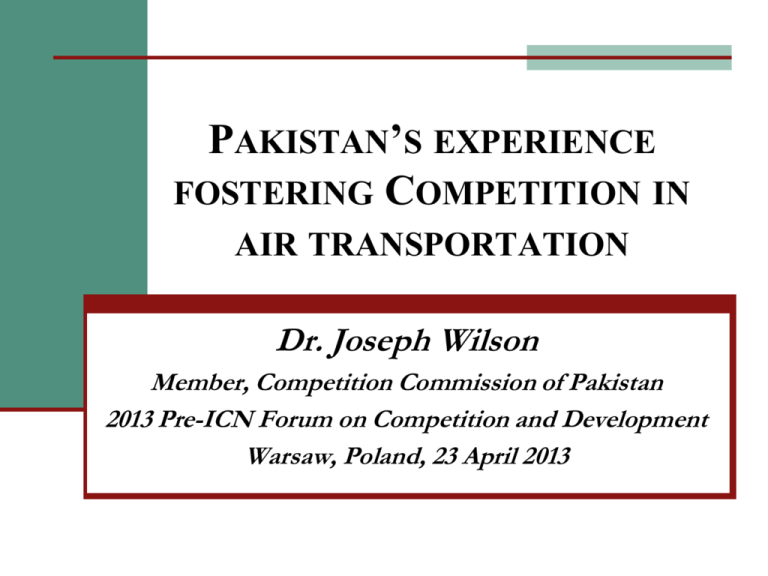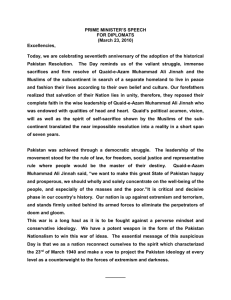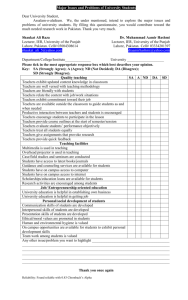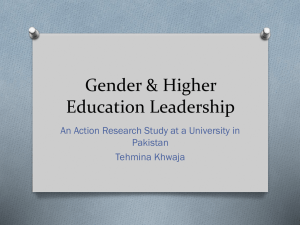Pakistan's Experience Fostering Competition in Air Transportation
advertisement

PAKISTAN’S EXPERIENCE FOSTERING COMPETITION IN AIR TRANSPORTATION Dr. Joseph Wilson Member, Competition Commission of Pakistan 2013 Pre-ICN Forum on Competition and Development Warsaw, Poland, 23 April 2013 Challenge : Dominant SOE One reason for forming SOEs is that they are expected to behave differently from what private entities might. For example in the case of transportation: To serve socio-economic routes To ply on un-economic routes in order to serve Universal Service Obligation (USO) The question, then, is whether the state’s objectives can be pursued in a manner that does not impair the competitive landscape. Competition Law in Pakistan: History Monopolies and Restrictive Trade Practices (Control and Prevention) Ordinance, 1970 Section 25 exempted state-owned enterprises from the application of the MRTPO. In October 2007, a new competition regime was introduced through the Competition Ordinance, which took away the exemption granted to SOEs from the application of competition Law. In October 2010, the ordinance was enacted as the Competition Act of 2010. Competition Act, 2010 Competition Act, 2010 The Competition Act seeks to provide for free competition in all spheres of commercial and economic activity to enhance economic efficiency [Economic Efficiency of the industry through competitive process ] and to protect consumers from anti-competitive behaviour.” Further, section 1(3) of the Act states that the Act “shall apply to all undertaking and all actions or matters that take place in and distort competition within Pakistan.” Competition Act, 2010: 29 Competition advocacy – The Commission shall promote competition through advocacy which, among other, shall include: (a) creating awareness and imparting training about competition issues and taking such other actions as may be necessary for the promotion of a competition culture. (b) reviewing policy frameworks for fostering competition and making suitable recommendations for amendments to this Act and any other law that affect competition in Pakistan to the Federal Government and Provincial Governments; Aviation Sector in Pakistan Market Players Pakistan International Airline (formed in 1955 90% State Owned) 40% market share for international travel by Pakistani 75 % market share of domestic traffic Shaheen Air International (formed in 1993 – Privately owned) Air Blue (formed in 2004 – Privately owned) Bilateral Air Services Agreements Pakistan has signed 53 Bilateral Air Services Agreements In 11 instances, Pakistan exchanges the right to designate two or more airlines on international routes, rather than upholding the single designation flag bearing airline paradigm. WTO : Air Liberalization Index (ALI) In 2006, the World Trade Organization -pursuant to its mandate to review air transportation under the General Agreement on Trade in Services – developed an Air Liberalization Index (ALI), ALI assesses the relative liberalness of air transportation agreements taking into consideration elements such as: the pricing regime applicable, the degree of governmental control of capacity, restrictions on the number of operators that can fly between country-pairs, the traffic rights exchanged, and foreign ownership restriction on designated airlines ALI ranges from 0 to 50, where 50 means most liberal. Pakistan BASAs : ALI Score Of the 53, 31 agreements have highly restrictive terms, with an ALI of between 0-6 17 agreements can be found to have limited liberal terms with ALI of 6-12 4 agreements –the UK, Macao, Singapore, and Iran can be considered to contain multiple liberal terms, as they have an ALI of between 13 and 20. 1 agreement – with the US -contained advanced, open skies type clauses, and rated 28 points The average ALI of Pakistan’s bilateral agreements is 7.2 Cases Related to State-owned Airline Dealt by the Commission PIA Hajj fares case (§§ 3 & 4 ) PIA ticket cancellation charges case (Abuse of dominance) PIA Hajj Fares Case The Commission took notice of media reports that PIA was charging exorbitant Hajj fares. In 2008, rates were increased almost by 100 percent. From Rs. 38,500 in 2007 to Rs. 70,000 for the South and from Rs. 46,200 to Rs. 85,000 for North sectors – infringing section 3 (abuse of dominance) The Inquiry Report also noted that quota sharing agreement between PIA and Saudi Arabian Airline [through their respective governments] – Infringing section 4 (Prohibited Agreement) PIA Hajj Fares Case: Decision (November 2009) For section 3 violation restitution was ordered For section 4, the Commission issued a policy note to the government for modifying the Bilateral Air Services Agreement (BASA) with Saudi Arabia. The Government of Pakistan changed BASA from single designation airline to two designations in March 2010. Fostering Entry One airline each from Pakistan and Saudi Arabia was allowed to fly direct between Pakistan and Saudi Arabia Shaheen Air (Pakistan) Nas Air (Saudi Arabia) Increased Choice for Passengers Shaheen Air Flight Schedule for direct flights to Saudi Arabia Route Frequency Riyadh – Lahore 2 Flights Wednesday/Saturday Riyadh-- Peshawar 2 Flights Tues/Fridays Riyadh – Islamabad 1 Flight Dammam – Islamabad 4 Flights Tues/Thurs/Sat/Sundays Dammam- Karachi 2 Flighs Total flights 11 Flights/ per week were added Sundays Mon/Sats Hajj Flights: Shaheen Air NAS Air Flight Schedule 19 flights per week from Riyadh to various points in Pakistan Route Frequency Riyadh -- Islamabad 7 Flights per week Riyadh -- Lahore 7 Flights per week Riyadh – Peshawar 5 Flights per week Total 19 Flights per week Effect of competition on Hajj Fares Hajj Fares in Pak Rupees 120000 Four years later same price CCP Took Notice 100000 PKR 80000 North 60000 South 40000 20000 0 2007 2008 2009 2010 2011 2012 2013 Dollar – Rupee Parity Chart Dollar vs. PKR 120 100 PKR 80 60 Dollar 40 20 0 2007 2008 2009 2010 2011 2012 2013 Effect of competition on Hajj Fares in US Dollars Hajj Fares in US$ 1400 1200 US Dollars 1000 800 North South 600 400 200 0 2007 2008 2009 2010 2011 2012 2013 Subsidy of PKR26.4B Given to PIA by Government from 2002 to 2011 Equity contributed by GOP (Rs million) 4928 Note: bars highlighted in yellow represent profitable years for PIA whereas purple bars represent loss making years 4999 3433 2866 2101 1529 1405 891 933 FY 2008 FY 2009 500 FY 2002 FY 2003 FY 2004 FY 2005 FY 2006 FY 2007 FY 2010 FY 2011 Instances of Undue Advantages Given to State-owned Airline 50% rebate in turnover tax as compared to private airlines Allowed to fly even license fee long overdue Employees given free and preferred access to airport as compared to those of private airlines Policy notes issued by the Commission to remove these distortions. Concluding Remarks Level-playing field is a sine quo non for the new entrants to grow and to compete effectively with the local State-owned airline and other international airlines. Advocacy is an important tool available to Competition agencies to promote competitive neutrality, and to enhance economic efficiency in the economy. Advocacy is an inherent function of competition agencies regardless whether such function is assigned in the parent statute or not. THANK YOU FOR YOUR ATTENTION







